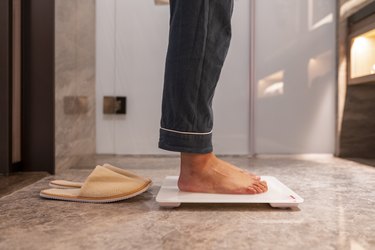
There are two ways to measure your health and fitness: body mass index (BMI) and body fat percentage. Though many people talk about them interchangeably, BMI and body fat percentage should be used for different stages in your fitness journey. With an understanding of how each is used, you'll be able to track your fitness progress with ease and clarity.
Simplify with BMI
Video of the Day
BMI stands for body mass index. The two factors used to determine your BMI are your height and weight. Doctors often use BMI as simple and easy way to measure if a person is healthy, underweight or overweight.
Video of the Day
It's important to note that a BMI score isn't a hard rule about what a person should weigh, it's just an educated guess.
The formula to get your BMI score is (Your weight in pounds x 703) ÷ (Your height in inches x Your height in inches). The results of your BMI score are determined as follows: Below 18.5 is underweight; 18.5 to 24.9 is normal; 25.0 to 29.9 is categorized as overweight; and 30.0 or higher denotes obesity.
If You Work Out, BMI Isn't For You
BMI does have one major drawback--it doesn't take into account how much of your weight is muscle and how much of your weight is fat.
If you are an athlete or active, you are going to have more weight in muscle than the average person, and your BMI may not accurately reflect your health and fitness, or how healthy and fit you look. Many athletes have a higher than normal scale weight, despite being active and being lean. It's not unusual for a bodybuilder, football player or basketball player to have a BMI in the overweight or obesity category, despite the fact that they are obviously lean and fit.
This is where body fat percentage comes in. Body fat percentage is literally measuring what percentage of your body is made up of fat. Everything else is usually referred to as "lean tissue." This gives a more accurate representation of health, fitness and leanness for someone who is physically active.
The results of your body fat percentage are determined as follows:
For women, 10 to 12 percent is essential fat; 14 to 20 percent is in the athlete category; 21 to 24 percent is fit; 25 to 31 percent is acceptable; and 32 percent or more is an indication of obesity.
For men, 2 to 4 percent is essential fat; 6 to 13 percent is in the athlete category; 14 to 17 percent is fit; 18 to 25 percent is acceptable; and 25 percent or more is an indication of obesity.
Body Fat Percentage = Fat Mass ÷ Bodyweight
Let's say there are two women who are the same height and weight: Alice and Melissa.
Alice and Melissa are both 5 foot 4 inches and 140 lbs., and that means they both have a BMI of 24.
Alice doesn't work out, and eats junk food. She just controls her junk food portion sizes, and that keeps her scale weight down. Alice has 42 lbs. of fat and 98 lbs. of lean mass. That would mean that Alice is 30 percent body fat.
Melissa does a weight training workout and cardio 3 days per week and eats a healthy diet. Melissa has 28 lbs. of fat and 112 lbs. of lean mass. Melissa would be 20 percent body fat.
Even though Alice and Melissa both have the same scale weight, they have drastically different looking bodies, and that's reflected in their body fat percentages being at opposite ends of the spectrum.
BMI and Normal Weight Obesity
Over half of Americans have normal BMI, or normal scale weight, and high body fat percentage, according to research reported in 2008.
Researchers are now calling this normal weight obesity and report that it's just as unhealthy as having a high scale weight.
BMI and Skinny Fat
Instead of say normal weight obesity, personal trainers have simply dubbed the condition "skinny fat." Having a normal scale weight and a high body fat percentage explains how a person can be skinny through most of his body and still have fat covering up his abs.
Body Fat Percentage and Abs
The dirty little secret of the personal training industry is that the only way to get a flat stomach and visible abs is to have a body fat percentage in the athlete range.
Most people in the gym are worried about doing crunches, sit-ups and core strength exercises. Meanwhile, the people who have the leanest stomachs and abs are the ones who changed their diet and are doing intense full body workouts to lower their body fat percentage.
The Right Tool for the Job
If you aren't working out, or if you are in your first 3 to 6 months of working out, then it's fine to use your BMI to track progress. After that point, your focus should shift away from BMI. In the long term, body fat percentage will be the best gauge of your health and fitness.